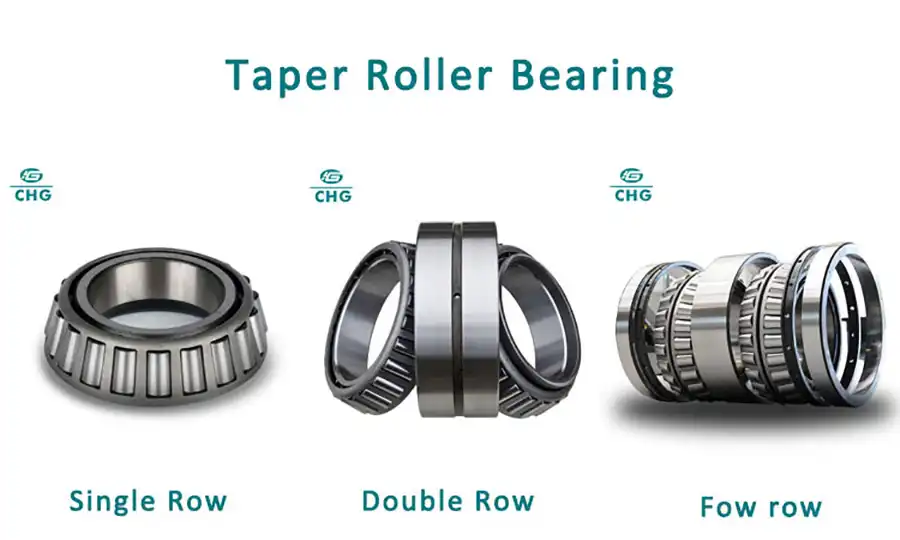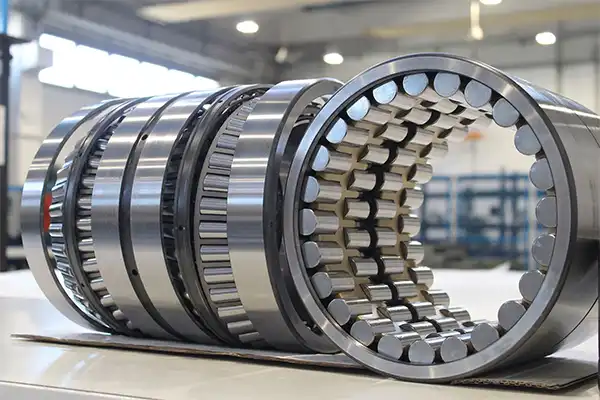What Are the Common Problems with Large Tapered Roller Bearings?
Large tapered roller bearings are critical components in heavy-duty applications, from industrial machinery to transportation systems. These bearings handle both radial and axial loads simultaneously, making them essential in demanding environments. Despite their robust design, large tapered roller bearings can experience various problems during operation that lead to reduced efficiency, unexpected downtime, and costly replacements. Understanding these common problems is crucial for maintenance professionals and engineers who aim to maximize equipment reliability and service life.

What Causes Premature Failure in Large Tapered Roller Bearings?
Improper Installation Techniques
Improper installation is a leading cause of premature failure in large tapered roller bearings. When installed incorrectly, these bearings experience abnormal stress distributions that accelerate wear. Common installation errors include misalignment during mounting, improper preload settings, and incorrect fitting tolerances. Failing to follow manufacturer specifications compromises the bearing's internal geometry, leading to uneven load distribution across the rollers. This imbalance creates localized stress concentrations that rapidly deteriorate the bearing's raceways and rolling elements. Additionally, improper handling during installation can introduce contaminants or cause physical damage to the components. Even microscopic dents on a large tapered roller bearing's precision-engineered surfaces can serve as initiation points for progressive damage. Professional installation using proper tools and techniques is essential for optimal performance and longevity.
Inadequate Lubrication Practices
Lubrication issues significantly contribute to the premature failure of large tapered roller bearings. These bearings require proper lubrication to form a protective film between rolling elements and raceways, reducing friction and preventing metal-to-metal contact. When lubrication is inadequate, excessive heat generation leads to accelerated wear and potential seizure. Common lubrication problems include insufficient quantity, degraded quality, or inappropriate viscosity for the operating conditions. In high temperatures, conventional lubricants may break down rapidly, while in cold conditions, they may become too viscous. The tapered geometry creates unique lubrication challenges, as centrifugal forces tend to throw lubricant away from critical contact areas. Establishing a proper lubrication schedule, selecting appropriate lubricants based on operating conditions, and implementing contamination control measures are essential for preventing lubrication-related failures in large tapered roller bearings.

Excessive Load Conditions
Subjecting large tapered roller bearings to loads beyond their design specifications invariably leads to premature failure. While engineered to withstand substantial combined loads, every bearing has specific load ratings that shouldn't be exceeded. Overloading can occur due to design flaws, operational changes without corresponding bearing upgrades, or unexpected shock loads. When a large tapered roller bearing experiences excessive forces, the contact stresses between rollers and raceways increase dramatically, leading to subsurface fatigue and accelerated wear. The tapered design makes these bearings particularly sensitive to axial load variations, as changes directly impact the contact angles and internal load distribution. Excessive loads can also generate abnormal heat, reducing lubricant effectiveness. Regular monitoring of operating conditions and appropriate safety factor selection during machine design are critical for preventing overload-related failures.
How Do Environmental Factors Affect Large Tapered Roller Bearing Performance?
Temperature Extremes and Thermal Cycling
Temperature extremes significantly impact the performance and lifespan of large tapered roller bearings. High temperatures accelerate lubricant degradation and cause metal components to expand at different rates, potentially altering critical internal clearances. This thermal expansion can lead to increased friction and dangerous escalating temperature cycles. Conversely, cold environments can cause lubricant thickening and inadequate oil film formation. Most damaging is thermal cycling, where large tapered roller bearings experience repeated heating and cooling, creating dimensional changes that lead to fretting and fatigue damage. Condensation during cooling may introduce moisture, promoting corrosion. Selecting bearings with appropriate materials for the expected temperature range and choosing suitable lubricants are essential strategies for mitigating these thermal challenges.

Contamination and Ingress Protection Challenges
Contamination poses a significant threat to large tapered roller bearing performance. These precision components depend on microscopically smooth contact surfaces, and even small contaminant particles can disrupt this interface. When hard particles enter a large tapered roller bearing, they become trapped between rolling elements and raceways, causing abrasive wear that damages precision surfaces. Liquid contaminants, particularly water, promote corrosion and displace lubricant. The tapered design creates unique sealing challenges, as angled surfaces can be difficult to protect with conventional seals. Ingress protection requires appropriate housing design, effective sealing solutions, and regular maintenance practices. In harsh environments, specialized sealing arrangements such as labyrinth seals or air purge systems may be necessary to protect these components from environmental contamination.
Moisture and Corrosion Impacts
Moisture exposure represents an insidious threat to large tapered roller bearings, initiating corrosion processes that rapidly degrade performance. When water penetrates bearing housings, it creates conditions for both surface corrosion and localized corrosion mechanisms. Surface rust generates abrasive particles that contribute to accelerated wear, while pitting corrosion creates stress concentration points that develop into fatigue failures. The problem becomes particularly acute in standby equipment, where condensation forms during temperature fluctuations while the absence of rotation prevents lubricant from providing protection. Many industries where large tapered roller bearings are employed inherently involve wet environments that exacerbate these challenges. Addressing moisture-related issues requires appropriate bearing material selection, effective sealing arrangements, water-resistant lubricants, and regular inspection protocols specifically targeting signs of corrosion.
What Maintenance Practices Can Extend Large Tapered Roller Bearing Life?
Proper Monitoring and Condition-Based Maintenance
Implementing effective monitoring and condition-based maintenance strategies is crucial for maximizing the service life of large tapered roller bearings. Condition monitoring allows maintenance teams to make decisions based on the actual state of the bearing, optimizing intervention timing. Vibration analysis can identify specific bearing defects such as raceway flaws or roller damage in large tapered roller bearings months before failure. Temperature monitoring offers another valuable indicator, as bearing temperatures rise as damage progresses. Oil analysis provides complementary insights by detecting wear particles in the lubricant. The sophisticated geometry of large tapered roller bearings creates unique vibration signatures that require specialized analysis techniques to diagnose accurately, making investment in proper training essential for successful implementation of these monitoring programs.
Alignment and Balancing Procedures
Proper alignment and balancing significantly extend the operational life of large tapered roller bearings. Even minor misalignment can dramatically alter load distribution patterns, creating localized stress concentrations that accelerate fatigue failure. Shaft misalignment forces the bearings to compensate for angular or parallel offset errors, generating excessive edge loading on rollers and raceways. The tapered geometry makes these bearings particularly sensitive to alignment issues, as misalignment affects the critical contact angles between rollers and raceways. Similarly, unbalanced rotating components create dynamic loads that cycle with each rotation. Modern laser alignment systems allow for adjustments to micron-level accuracy. When performing alignment on equipment with large tapered roller bearings, technicians must account for thermal growth during operation. Establishing regular alignment and balancing verification provides significant returns through extended bearing life and improved equipment reliability.
Lubricant Selection and Analysis Programs
Implementing comprehensive lubricant selection and analysis programs represents one of the most cost-effective strategies for extending the life of large tapered roller bearings. The lubricant forms an elastohydrodynamic film that prevents metal-to-metal contact, removes heat, and protects against corrosion. Selecting the optimal lubricant requires consideration of operating speed, load characteristics, temperature range, and environmental conditions. Regular analysis becomes essential for maintaining its protective properties. Oil analysis programs should include viscosity testing, particle counting, and water content measurement. These analytical techniques allow maintenance teams to detect problems early and make informed decisions about lubricant replacement intervals. For grease-lubricated large tapered roller bearings, establishing appropriate re-lubrication schedules based on operating conditions rather than arbitrary time intervals helps ensure continuous protection.
Conclusion
Understanding and addressing the common problems associated with large tapered roller bearings is essential for maximizing their operational life and reliability. From installation issues and lubrication challenges to environmental factors and maintenance practices, each aspect plays a crucial role in bearing performance. By implementing proper monitoring techniques, ensuring correct alignment, and selecting appropriate lubricants, maintenance professionals can significantly extend bearing service life while reducing unexpected failures and associated downtime.
Luoyang Huigong Bearing Technology Co., Ltd. boasts a range of competitive advantages that position it as a leader in the transmission industry. Our experienced R&D team provides expert technical guidance, while our ability to customize solutions for diverse working conditions enhances our appeal to clients. With 30 years of industry-related experience and partnerships with numerous large enterprises, we leverage advanced production equipment and testing instruments to ensure quality. Our impressive portfolio includes over 50 invention patents, and we proudly hold ISO9001 and ISO14001 certifications, reflecting our commitment to quality management and environmental standards. Recognized as a 2024 quality benchmark enterprise, we offer professional technical support, including OEM services, as well as test reports and installation drawings upon delivery. Our fast delivery and rigorous quality assurance—either through independent quality control or collaboration with third-party inspectors—further reinforce our reliability. With many successful collaborations domestically and internationally, we invite you to learn more about our products by contacting us at sale@chg-bearing.com or calling our hotline at +86-0379-65793878.
References
1. Harris, T. A., & Kotzalas, M. N. (2021). Essential Concepts of Bearing Technology. CRC Press.
2. Palmgren, A. (2019). Ball and Roller Bearing Engineering. SKF Industries, Inc.
3. Hamrock, B. J., & Dowson, D. (2018). Ball Bearing Lubrication: The Elastohydrodynamics of Elliptical Contacts. John Wiley & Sons.
4. Williams, J. A. (2020). Engineering Tribology: The Principles and Applications of Tribological Analysis to Bearing Design and Lubrication. Cambridge University Press.
5. Eschmann, P., Hasbargen, L., & Weigand, K. (2019). Ball and Roller Bearings: Theory, Design and Application. John Wiley & Sons.
6. Tallian, T. E. (2022). Failure Atlas for Roller Bearings in Rolling Element Bearings. ASM International.

